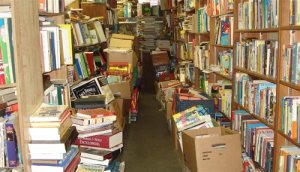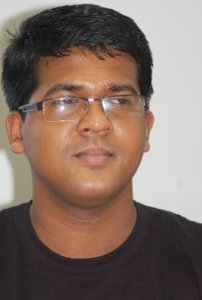 Occasionally I’ll crowdsource, as it were, a childhood memory. I was born and grew up in Oshawa, Ontario, living there between 1957 and 1976. Other than brief work-related stays from December 1983 to September 1984, and again from June to September 1992, I haven’t lived there since 1976, some 46 years ago. So when I needed help recalling a particular used and rare books dealer, my go-to place for research was the private Facebook group Vintage Oshawa, which has about 19,400 members and describes itself as “a place to post pictures, memorabilia & share tales of Oshawa past (pre-1980).” After all, 19,400 heads might be better than one in this case, I reasoned. And I had success almost four years ago back in May 2018 when I asked in classic Facebook style “who remembers” Rose Bowl Fish and Chips that operated at the corner of Bond and Prince streets? More than 200 members of the group either liked the question or responded with a comment.
Occasionally I’ll crowdsource, as it were, a childhood memory. I was born and grew up in Oshawa, Ontario, living there between 1957 and 1976. Other than brief work-related stays from December 1983 to September 1984, and again from June to September 1992, I haven’t lived there since 1976, some 46 years ago. So when I needed help recalling a particular used and rare books dealer, my go-to place for research was the private Facebook group Vintage Oshawa, which has about 19,400 members and describes itself as “a place to post pictures, memorabilia & share tales of Oshawa past (pre-1980).” After all, 19,400 heads might be better than one in this case, I reasoned. And I had success almost four years ago back in May 2018 when I asked in classic Facebook style “who remembers” Rose Bowl Fish and Chips that operated at the corner of Bond and Prince streets? More than 200 members of the group either liked the question or responded with a comment.
How we consolidate, access and sometimes geographically transpose locations in long-term memory is a complex process beyond the ken of my knowledge of neuroscience, but here is what I asked earlier today based on what I suspected to be a real but perhaps flawed memory:
“Does anyone recall a used bookstore on Division Street in Oshawa in the 1970s and 1980s, not far from the old General Motors North Plant? Brown brick, I think, like other buildings in the neighbourhood. A bit dingy in terms of lighting inside but not without its charms. I think the name might have started with the letter M, but it was all quite a while ago. Given that we’re talking about 40 or 50 years ago, it’s also possible I’ve conflated the idea of a bookstore on Division Street in the area of the GM North Plant with a health food/Asian vegetable market store in that location and the bookstore was on the west side of Simcoe Street South, near John Street East, not far south of a Pepi’s Pizza location on that corner. I still have fond, though distant memories of my friend Mike Byrne, working there as a cook in high school circa 1973-74, and wrangling his friends the odd late-night pie … the pepperoni pizza … greasy, yes, sure. But superb also.
The mention of Pepi’s Pizza was perhaps not essential to answering the question, given the focus is on a bookstore and Asian grocery store, but mentioning a favourite childhood eatery in Oshawa, be it Pepi’s or Mother’s Pizza Parlour and Spaghetti House, or perhaps Red Barn or Burger Chef, always is a good memory prompt for any even tangentially related story I’ve found as a writer.
So what did I learn today from folks in Vintage Oshawa? When I said, I think the name might have started with the letter M,” turns out I was correct as dozens of readers spelled it out for me as Morgan Self, which I instantly knew as correct. But commenters went well beyond that in their help. Apparently, there were two Morgan Selfs who were proprietors of their … err … self-named bookstore, father and son. And they lived on Shakespeare Avenue another commenter noted (their bookstore was at 84 Simcoe St. S.) Now, I confess my fact-checking skills as a blogger aren’t perhaps as well-honed as they had to be as a pre-Google and pre-Wikipedia copy editor on the rim at daily newspapers, but I just had to Google Shakespeare Avenue to make sure this was by the book and there was such a street in Oshawa (I didn’t recall it) and I wasn’t being audaciously pranked on social media prior to April 1. Turns out to be legit. There is such a street. Whether the book-selling Selfs lived on it would take more verification for a newspaper back in the day, but for us present-day bloggers, not so much. Editors in their day were the last-line-of-defence fact checkers. When you wear a writer’s hat, you are a storyteller and there’s an admonition that a writer should never let the facts stand in the way of a good story. This was true even before 2017 when Sean Spicer came along and elevated the notion to high principle. That said, the photograph accompanying this post is admittedly for illustration purposes only. It is not the inside of the long-gone Morgan Self bookstore in Oshawa. At least I think it’s not.
You can also follow me on Twitter at: https://twitter.com/jwbarker22
Tag Archives: Writers
Who’d a thunk it? Readers says it’s a toss-up when it comes to whether robo-journalists write better than human journalists
OK … we’ve all heard the phrase “fishwrap” applied derogatorily by critics assessing the quality of newspapers wherever they live from time to time. Methinks some weeks that does a disservice to how my favourite pickerel from Paint Lake should be treated, but it isn’t just local newspapers that are problematically bad at times. Take the venerable Associated Press, affectionately known by working journos simply as the AP. They managed to move this alert last Wednesday: “BC-APNewsAlert/17. New York Yankees Hall of Fame catcher Yogi Bear has died. He was 90.” Actually, Yogi Bear, the beloved Hanna-Barbera cartoon character is only 57. He was created in 1958, making his début as a supporting character in The Huckleberry Hound Show, and was the first breakout character created by Hanna-Barbera and was eventually more popular than Huckleberry Hound.
Yogi Berra, the beloved baseball player, on the other hand, was created in 1924 and born in 1925. A native of St. Louis, Berra signed with the New York Yankees in 1943 before serving in the U.S. Navy in the Second World War. He made his major league début in 1946 and was a stalwart in the Yankees’ lineup during the team’s championship years in the 1940s and 1950s.
Berra was a power hitter and strong defensive catcher. He caught Yankees’ pitcher Don Larsen’s perfect game on Oct. 8, 1956, in Game 5 of the 1956 World Series against the Brooklyn Dodgers, the only perfect game in Major League Baseball (MLB) post-season history. After playing 18 seasons with the Yankees, Berra retired following the 1963 season. Berra was also famous for his string of truisms, tautologies and malapropisms, including “Nobody goes there any more; it’s too crowded,” along with, “It ain’t over til it’s over” or, “Anyone who is popular is bound to be disliked,” as well as, “Half the lies they tell about me aren’t true” and, “If you ask me anything I don’t know, I’m not going to answer.” My personal favourite, which I managed to inject into several columns, editorials or news stories over the years, was the well-known, “This is like déjà vu all over again,” which I had used again as recently as Aug. 24, less than a month before Yogi Berra died.
It was while I was pondering how a boo boo like the Yogi Bear/Yogi Berra obituary mix-up happens in journalism (I suspect the eagle-eyed Ranger John Francis Smith from Jellystone Park would have known the difference) that I came across the latest information on robo-journalism (not to be mixed up with Tory robo-calls during the 2011 federal election campaign, I should point out to my friends still remaining in Canadian journalism.) Turns out that unlike most human journalists, who are for the most part seriously mathematically challenged, robot journalists that already work for such illustrious newspapers as the New York Times and Los Angeles Times, as well as Forbes, the storied business magazine, have shown a natural aptitude for data, making them ideal for the sports and business desks, and as such are now about ready to branch out into breaking news and investigative journalism.
Neil Sharman (believed to be a human writer) and former head of research and insight at Telegraph Media Group on Buckingham Palace Road in London, writing Sept. 22 in TheMediaBriefing, also based in London, noted that robots, “Like junior reporters … can learn from and draw on a back catalogue of great writing – but with more powerful memories and analytical techniques.” You can read Sharman’s full piece here: http://www.themediabriefing.com/article/robo-journalism-the-future-is-arriving-quickly
“Machines are adept at investigating data sets,” Sharman says. “Publishers have set them to tax records, homicide data, meteorological reports and more –looking for patterns and describing them. They’re thorough, not prone to error and they’re fast.
“The LA Times uses robo-journalism to break news about earthquakes because machines can analyse geological survey data faster than a human. It takes under five minutes to spot a story and get it online.”
Tim Adams, a staff writer for the “The Observer: The New Review” at London’s The Guardian newspaper, wrote a piece June 28 on Kris Hammond, a professor of journalism and computer science at Northwestern University and co-founder and chief scientist at Chicago-based Narrative Science, which developed a writing program for robots known as “Quill.” Hammond also founded the University of Chicago’s Artificial Intelligence Laboratory. He told Adams, “we are humanizing the machine and giving it the ability not only to look at data but, based on general ideas of what is important and a close understanding of who the audience is, we are giving it the tools to know how to tell us stories.”
Adams observes, “It’s not deathless prose – at least not yet; the machines are still ‘learning’ day by day how to write effectively – but it’s already good enough to replace the jobs once done by wire reporters. Narrative Science’s computers provide daily market reports for Forbes as well sports reports for the Big Ten sports network. Hammond predicts that 90 per cent of journalism will be written by computer by 2030. Automated Insights, one of Narrative Sciences competitors, based in Durham, North Carolina, does all the data-based stock reports for AP.
Adams also notes that “last year, a Swedish media professor, Christer Clerwall, conducted the first proper blind study into how sports reports written by computers and by humans compared. Readers taking part in the study suggested, on the whole, that the reports written by human sports journalists were slightly more accessible and enjoyable, but that those written by computer seemed a little more informative and trustworthy.”
Clerwall, an assistant professor in media and communication studies at Karlstad University in Karlstad, Sweden concluded that “perhaps the most interesting result in the study is that there are [almost] no… significant differences in how the two texts are perceived.”
In terms of narrative arcs, Hammond says, “Like any decent hack, the machine is coming to learn that there are only five or six compelling tales available: back from the brink, outrageous fortune, sudden catastrophe and so on.”
You can also follow me on Twitter at: https://twitter.com/jwbarker22
Not for the faint of heart: Father Subhash Joseph to transfer from St. Lawrence Church to the Church of St. Gertrude in Pelican Narrows and the Church of Our Lady of Seven Sorrows in Sandy Bay, both in remote northeastern Saskatchewan
Days after he began what was originally expected to be a second three-year appointment as co-pastor of St. Lawrence Roman Catholic Church here in Thompson, Manitoba, Father Subhash Joseph, a missionary priest from India, said July 18 he is being transferred to the repair-challenged Church of St. Gertrude in Pelican Narrows, Saskatchewan, located 120 kilometres northwest of Flin Flon; 388 kilometres northeast of Prince Albert and 525 kilometres northeast of Saskatoon, and the Church of Our Lady of Seven Sorrows in Sandy Bay, at road’s end for the gravel winding road, 72 kilometres north of Pelican Narrows. The transfer, requested by Father Joseph, as he is known, and approved by Archbishop Murray Chatlain, archbishop of the Archdiocese of Keewatin-Le Pas, will probably take place in October. He will serve in Pelican Narrows and Sandy Bay by himself, replacing Father Susai Jesu, an Oblate, also from India.
Father Joseph, along with Father Guna Pothula, his co-pastor at St. Lawrence Church in Thompson, are both from India and members of the Congregation of the Missionaries of St. Francis de Sales, founded by Father Peter Marie Mermier from Vouray in the parish of Chaumont en Genevois and the Diocese of Annecy in the Savoy region of France in October 1838 for parish mission, foreign mission and youth education. They are also known as the Fransalians. Pope Pius XI proclaimed St. Francis de Sales in 1923 as the patron saint of writers and journalists. Francis de Sales was born in France and lived at the time of the Protestant Reformation, becoming Bishop of Geneva. He had lots of exposure to Calvinism and predestination and was noted for his diplomacy in the volatile, heated religious climate of the day in Switzerland. He’s honored as one of the doctors of the Catholic Church and the worldwide Anglican Communion.
The missionary order allows it priests to live abroad for up to 10 years. Father Joseph and Father Guna arrived in Thompson together three years ago in July 2012. Their requests to have their terms extended for a further three years were approved earlier this year by the provincial superior of their missionary order in India and the local archdiocese here. Father Guna, who will be staying on at St. Lawrence in Thompson, will now be joined in due course by another priest, likely from Andhra Pradesh in southeastern India where he is from, and also a member of the Congregation of the Missionaries of St. Francis de Sales.
In Cree, Pelican Narrows is called Opawikoscikcan, which means “The Narrows of Fear.” The community consists of the Northern Village of Pelican Narrows and Pelican Narrows 184B Indian Reserve, the administrative centre of the Peter Ballantyne Cree Nation. The combined population is about 2,700, with more than two-thirds of the population – about, 1,900 of the 2,700 residents – living on the reserve. Sandy Bay’s name in Cree is Wapaskokimawn, meaning “okimaw,” which is “boss” in Cree, or “non-native agent.” With a combined population of about 1,200, the community, like Pelican Narrows, is also split into two parts: the Northern Village of Sandy Bay and Wapaskokimaw Indian Reserve No. 202, with about one quarter of Sandy Bay’s combined population being members of the Peter Ballantyne Cree Nation.
Major businesses and industry in Pelican Narrows consist of the Co-op Fisheries and Fish Plant, The Northern Store, Mum’s Restaurant, Charles Confectionery, PBCN Band Store, Pearson Enterprises, Nikatosik Forestry and Pelican Narrows Air Services.
In 1876, Father Étienne Bonnald, a member of the Oblates of Mary Immaculate (O.M.I.), often known simply as Oblates, and also a missionary order, sought to establish a Catholic presence within the Village of Pelican Narrows, which had started out as a Protestant community. St. Gertrude was erected two years later in 1878.
The Church of St. Gertrude in Pelican Narrows, where 90 per cent of the parishioners are Cree, had fallen into such a state of disrepair in recent years, Catholic Missions In Canada identified it as a mission church it was going to help fund repairs for. St. Joseph’s Catholic Parish Social Justice Committee in Moose Jaw, at the suggestion of Catholic Missions In Canada, began helping with repairs through its “St. Gertrude’s Project” in 2010. You can watch a short YouTube video on the project here at: https://www.youtube.com/watch?v=IeLwJCejEJQ
Les Oblats de Marie Immaculée, or The Missionary Oblates of Mary Immaculate (O.M.I.), established the first mission at Ile-À-la-Crosse, Saskatchewan in 1860.
Another Oblate priest, Father Ovide Charlebois, arrived as pastor of St. Gertrude in 1900. While in Pelican Narrows, he constructed a new church with a bell, and a statue of Our Lady of Lourdes was erected. Ten years later, on March 4, 1910 when the Vicariate Apostolic of Keewatin, forerunner to today’s Metropolitan Archdiocese of Keewatin Le Pas, was created from territory of the Diocese of Prince Albert, and Charlebois, elevated to bishop, was appointed as its first ordinary on Aug. 8, 1910 and installed as vicar apostolic on March 7, 1911.
The Archdiocese of Keewatin-Le Pas takes in some 430,000 square kilometres and stretches across the northern parts of three provinces – Saskatchewan, Manitoba and a small portion of Northwestern Ontario.
The farthest point west is La Loche, Saskatchewan., near the Alberta border. The farthest point north is Lac Brochet here in Manitoba. The distance from Our Lady of the Sacred Heart Cathedral in The Pas, which serves as the archdiocesan seat, to La Loche by car, is 850 kilometres – an 8 1/2 -hour drive – and the archbishop, as shepherd of the flock, has to travel through the Diocese of Prince Albert in Saskatchewan to reach La Loche in his own archdiocese on travelling pastoral visits.
The farthest point east travelled is Sandy Lake, Ont., a fly-in and Northern Ontario Winter Road Network-only remote Oji-Cree First Nations community in Northwestern Ontario, 450 kilometres northeast of Winnipeg and 600 kilometres northwest of Thunder Bay.
The distance from The Pas to Sandy Lake is a combined six-hour drive to Winnipeg, followed by a one-hour plane ride.
Lac Brochet is reached by a four-hour drive from The Pas to Thompson and then an hour flight from Thompson to Lac Brochet. En route to Lac Brochet, the archbishop sometimes stays at the rectory at St. Lawrence Church on Cree Road in Thompson overnight waiting to catch a flight.
The Congregation of the Missionaries of St. Francis de Sales has long had a presence in India, dating back to 1846. The Visakhapatnam Province of the Congregation of the Missionaries of St. Francis de Sales in India also has missions in Trinidad and Papua New Guinea, as well as the Archdiocese of Keewatin-Le Pas here in Canada.
Father Joseph joined the seminary at the age of 16 in 1998 and was ordained a priest in 2010. He is from Therthally in Kerala on the Malabar Coast in southwestern India, which dates back some 20 centuries to the Christians of St. Thomas, named for Saint Thomas the Apostle, also known as “Doubting Thomas,” who is believed in apocryphal literature to have arrived in India around 52AD, seeking converts to Christianity. He was martyred, it is believed, about 20 year later in 72AD, near Mylapore, India, lanced by a spear as he prayed kneeling on a stone.
You can also follow me on Twitter at: https://twitter.com/jwbarker22





